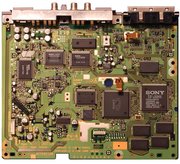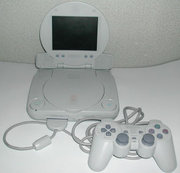PlayStation
|
|
Pslogo.jpg
The PlayStation (Japanese: プレイステーション) is a video game console of the 32-bit era, first produced by Sony Computer Entertainment in the 1990s. The original PlayStation was the first of the PlayStation series of console and hand-held game devices, which has included successor machines including the PSone, PlayStation 2, PlayStation Portable, and the forthcoming PlayStation 3.
PlayStationConsole.jpg
The original PlayStation was produced in a light grey color
| Contents |
History
The PlayStation was launched in Japan on December 3, 1994, the USA on September 9, 1995 and Europe on September 29, 1995. In America, Sony enjoyed a very successful launch with titles of almost every genre including Toshinden, Twisted Metal, Warhawk, and Ridge Racer. Almost all of Sony and Namco's launch titles went on to produce numerous sequels.
The console was extremely popular, spawning the so-called "PlayStation Generation". Among many other games, the PlayStation is well known for the Tomb Raider, Final Fantasy, Resident Evil, Tekken, wipEout, Gran Turismo, Crash Bandicoot, Spyro, and Metal Gear Solid series of games. As of 18 May 2004, Sony has shipped 100 million PlayStation and PSOne consoles throughout the world. As of March 2004, there were 7,300 software titles available with cumulative software shipment of 949 million.
Nintendo and Sony's earlier co-operation in developing a CD-ROM based system (see SNES) lead to the former filing a lawsuit claiming breach of contract and attempted, in U.S. federal court, to obtain an injunction against the release of the PlayStation, on the grounds that Nintendo owned the name. The federal Judge presiding over the case denied the injunction.
Variants
Playstation_Controller.jpg
Sony now produces a redesigned version of the original console, called the "PSone", in a smaller (and more ergonomic) case. The original PlayStation was often abbreviated to "PSX", the system's indevelopment codename, until 2003, when a new system formally named the PSX was introduced by Sony (an upgraded PlayStation 2 which includes a DVD burner, a hard drive, and digital video recorder). The PlayStation is now officially abbreviated as the "PS1" or "PSOne," although many people still abbreviate it "PSX".
A version of the PlayStation called the Net Yaroze was also produced. It is more expensive than the original PlayStation, coloured black instead of the usual gray, and most importantly, came with tools and instructions that allowed a user to be able to program PlayStation games and applications without the need for a full developers suite (which could cost many times the amount of a PlayStation). However, the Net Yaroze lacks many of the features the full developers suite provides. It is also unique in that it is the only official Sony PlayStation with no regional lockout; it will play games from any territory.
Another version that was colored blue (as opposed to regular console units that were gray in color) was available to game developers and select press. It had double the main RAM size (4 Megabytes instead of 2 Megabytes) and a CD-ROM emulator board connected to PC. It was also able to run in-development games which lacked region coding (which would be rejected by a normal PlayStation as though they were pirate copies). A few of these units eventually appeared for sale through somewhat dubious channels at high prices (~£299 when the PlayStation itself was selling at around £99).
The installation of a modchip allows PlayStation's capabilities to be expanded. This allows unauthorized copies of games to be played, but it also allows the playing of games from other countries. Since modchips allow playing games recorded on a regular CD-ROM, it created a wave of games developed without official Sony approval, using free GNU compiler tools.
Successors
Sony's successor to the PlayStation is the aptly titled PlayStation 2, which is largely compatible with its predecessor, in the sense that it can play most PlayStation games unmodified. This is done by embedding the most important parts of the PSOne inside the PlayStation 2 design. Unlike emulators that run on the PC, the Playstation 2 actually contains the original Playstation processor, allowing games to run exactly as they do on the Playstation. For Playstation 2 games this processor, called the IOP, is used for input and output (memory cards, DVD drive, network, and harddrive). Like its predecessor, the PlayStation 2 is based on bespoke hardware developed by Sony themselves.
The next generation of the PlayStation is known as PlayStation 3 or PS3 and expected to be launched in 2006. The PS3 appears to be the first game console to use grid computing technology.
The PlayStation Portable (abbreviated PSP) is a handheld game console first released in late 2004.
The PlayStation has historical links to an abortive CD-ROM add-on to the SNES, which would have been able to include large multimedia. For various reasons, including the failure of the Sega CD, that project was cancelled.
Screenshots
Specifications
Main CPU

MIPS R3000A-compatible (R3051) 32bit RISC chip running at 33.8688 MHz
The chip is manufactured by LSI Logic Corp. with technology licensed from SGI. The chip also contains the Geometry Transformation Engine and the Data Decompression Engine.
Features:
- Operating Performance of 30 MIPS
- Bus Bandwidth 132 Mb/s
- Instruction Cache 4 KB
- Data Cache 1 KB (non associative, just 1024 bytes of mapped fast SRAM)
Geometry Transformation Engine
This engine is inside the main CPU chip. It gives it additional (vector-)math instructions used for the 3D graphics.
Features:
- Operating Performance of 66 MIPS
- 360,000 Flat-Shaded Polygons per second
- 180,000 texture mapped and light-sourced polygons per second
Sony originally gave the polygon count as:
- 1.5 Million Flat-Shaded Polygons per second
- 500,000 texture mapped and light-sourced polygons per second
These figures were given as a ballpark figure for performance under optimal circumstances, and so are unrealistic under normal usage.
Data Decompression Engine
This engine is also inside the main CPU chip. It is responsible for decompressing images and video. Documented device mode is to read three RLE-encoded 16×16 macroblocks, run IDCT and assemble a single 16×16 RGB macroblock. Output data may be transferred directly to GPU via DMA. It is possible to overwrite IDCT matrix and some additional parameters, however MDEC internal instruction set was never documented.
Features:
- Compatible with MPEG-1 and H.261 files
- Operating Performance of 80 MIPS
- Directly connected to CPU Bus
Graphics Processing Unit
This chip is separate to the CPU and handles all the 2D Graphics processing, which includes the transformed 3D polygons.
Features:
- Maximum of 16.7 Million Colours
- Resolutions from 256×224 to 640×480
- Adjustable frame buffer
- Unlimited Colour Lookup Tables
- Maximum of 4000 8×8 pixel sprites with individual scaling and rotation
- Emulation of simultaneous backgrounds (for parallax scrolling)
- Flat or Gouraud shading, and texture mapping
Sound Processing Unit
Features:
- Can handle ADPCM sources with up to 24 channels and up to 44.1 kHz sampling rate
- Could perform digital effects including:
- Pitch Modulation
- Envelope
- Looping
- Digital Reverb
- Could handle up to 512Kb of sampled waveforms
- Supports MIDI instruments
- PC file name format: .PSF
Memory
- Main RAM: 2 Megabytes (4 Megabytes on "Blue" development console)
- Video RAM: 1 Megabyte
- Sound RAM: 512 Kilobytes
- CD-Rom Buffer: 32 Kilobytes
- Operating System ROM: 512 Kilobytes
- PlayStation Memory Cards have 128 Kilobytes of space in an EEPROM
CD-ROM
Features:
- Originally Single Speed, later replaced with a Two Speed drive, with a maximum data throughput of 300 KB/s
- XA Compliant
See also
Template:Dedicated video game consoles
- List of PlayStation games
- Sony
- Nintendo 64
- PlayStation 2
- MIDI
- PlayStation Sound Format
- 32-bit era
- PocketStation
- PlayStation 3
- PlayStation Portable
External links
- Unofficial Sony PlayStation FAQ (http://kontek.net/pp/technical/psx/playstat.txt) by James Dunford
- Game Infowire story on 100 million shipments (http://www.gameinfowire.com/news.asp?nid=4396/)
- PS Galleria (http://www.vidgames.com/) Oldest PlayStation fan-siteda:PlayStation
de:PlayStation el:PlayStation es:PlayStation eo:Sony PlayStation fr:PlayStation id:PlayStation it:PlayStation nl:PlayStation ja:プレイステーション no:PlayStation pl:Sony PlayStation pt:PlayStation ru:PlayStation fi:PlayStation simple:PlayStation sv:Playstation zh:PlayStation


